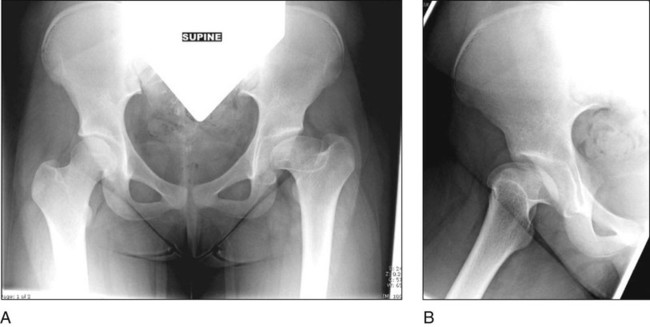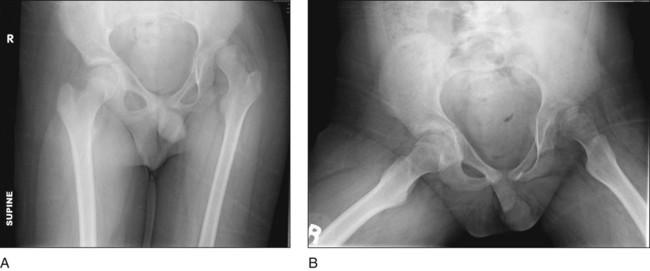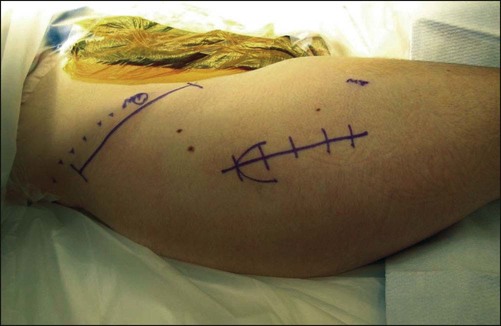• Figure 1 shows preoperative anteroposterior (AP) (Fig. 1A) and lateral (Fig. 1B) radiographs of a patient with right hip Legg-Calvé-Perthes disease. • Figure 2 shows preoperative AP (Fig. 2A) and frog lateral (Fig. 2B) radiographs of a candidate for Chiari pelvic osteotomy. • The Von Rosen view can demonstrate the incongruous relationship between the femoral head and acetabulum and also demonstrate the reducibility of the femoral head within the acetabulum.
Chiari Pelvic Osteotomy
Indications
 The Chiari pelvic osteotomy is a “salvage” procedure, which uses the ilium to form a “shelf” to cover over the femoral head and prevent subluxation. The osteotomy relies on metaplasia of the interposed hip capsule to form new fibrocartilage.
The Chiari pelvic osteotomy is a “salvage” procedure, which uses the ilium to form a “shelf” to cover over the femoral head and prevent subluxation. The osteotomy relies on metaplasia of the interposed hip capsule to form new fibrocartilage.
 This osteotomy is designed to treat acetabular dysplasia in the setting of painful hip subluxation and is considered in patients who demonstrate aspherical incongruity between the femoral head and dysplastic acetabulum.
This osteotomy is designed to treat acetabular dysplasia in the setting of painful hip subluxation and is considered in patients who demonstrate aspherical incongruity between the femoral head and dysplastic acetabulum.
 This osteotomy is particularly useful in neuromuscular hip pathology where acetabular deficiency is primarily posterolateral.
This osteotomy is particularly useful in neuromuscular hip pathology where acetabular deficiency is primarily posterolateral.
Examination/Imaging
Physical Examination
 Examination should begin with observed gait analysis to document if a limp is present and if it is a result of antalgia or Trendelenburg dysfunction.
Examination should begin with observed gait analysis to document if a limp is present and if it is a result of antalgia or Trendelenburg dysfunction.
 A careful hip range of motion is documented; in particular, internal and external rotation limits can give information as to where the damaged portion of the femoral head and possibily acetabulum exist.
A careful hip range of motion is documented; in particular, internal and external rotation limits can give information as to where the damaged portion of the femoral head and possibily acetabulum exist.
 A positive Trendelenburg’s test indicates abductor weakness. It is important to document abductor weakness with side lying and the presence of an adductor contracture.
A positive Trendelenburg’s test indicates abductor weakness. It is important to document abductor weakness with side lying and the presence of an adductor contracture.
 In a positive anterior apprehension test, with extension and external rotation, the patient experiences apprehension, pain, or perceived hip instability.
In a positive anterior apprehension test, with extension and external rotation, the patient experiences apprehension, pain, or perceived hip instability.
 In a positive anterior impingement test, with flexion, adduction, and internal rotation of the hip, the patient experiences pain and discomfort; this can be indicative of labral tear or anterior labral pathology.
In a positive anterior impingement test, with flexion, adduction, and internal rotation of the hip, the patient experiences pain and discomfort; this can be indicative of labral tear or anterior labral pathology.
 The Galleazzi sign is significant for fixed hip instability and subluxation/dislocation.
The Galleazzi sign is significant for fixed hip instability and subluxation/dislocation.
 In patients with neuromuscular hip pathology, one may appreciate a positive Ortolani sign, where the hip actively may be reduced with varying degrees of discomfort.
In patients with neuromuscular hip pathology, one may appreciate a positive Ortolani sign, where the hip actively may be reduced with varying degrees of discomfort.
Imaging Studies
 Imaging studies are designed to document the congruency of the femoral head within the acetabulum, the amount of anterior and lateral acetabular coverage of the femoral head, and the reducibility of the femoral head into the native acetabulum.
Imaging studies are designed to document the congruency of the femoral head within the acetabulum, the amount of anterior and lateral acetabular coverage of the femoral head, and the reducibility of the femoral head into the native acetabulum.


 Imaging should include weight-bearing standing AP radiographs centered on both hips, false profile views of both hips, and a Von Rosen (maximal abduction and internal rotation) view of both hips.
Imaging should include weight-bearing standing AP radiographs centered on both hips, false profile views of both hips, and a Von Rosen (maximal abduction and internal rotation) view of both hips.
 Reconstructed computed tomography scans can aid surgeons in determining the three-dimensional relationship between the acetabulum and femoral head and identifying locations of acetabular deficiency (anterolateral vs. posterolateral).
Reconstructed computed tomography scans can aid surgeons in determining the three-dimensional relationship between the acetabulum and femoral head and identifying locations of acetabular deficiency (anterolateral vs. posterolateral).
 Radial sequencing magnetic resonance imaging can aid surgeons in illustrating the condition and quality of the labrum and articular cartilage of the hip joint during the preoperative assessment.
Radial sequencing magnetic resonance imaging can aid surgeons in illustrating the condition and quality of the labrum and articular cartilage of the hip joint during the preoperative assessment.
 An intraoperative arthrogram is a useful study that demonstrates the dynamic stability of the hip and the relative congruency of the femoral head and acetabulum.
An intraoperative arthrogram is a useful study that demonstrates the dynamic stability of the hip and the relative congruency of the femoral head and acetabulum.
Surgical Anatomy
 In the ilioinguinal approach to the hip, superficially the lateral femoral cutaneous nerve (LFCN) is at risk in the interval between the sartorius muscle medially and the tensor fascia lata (TFL) muscle laterally. By remaining in the compartment of the TFL, the LFCN is protected during the surgical approach.
In the ilioinguinal approach to the hip, superficially the lateral femoral cutaneous nerve (LFCN) is at risk in the interval between the sartorius muscle medially and the tensor fascia lata (TFL) muscle laterally. By remaining in the compartment of the TFL, the LFCN is protected during the surgical approach.
 Deep in the interval between the direct head of the rectus femoris muscle and the gluteal muscles lie branches of the lateral femoral circumflex vessels. If necessary, these vessels can be ligated.
Deep in the interval between the direct head of the rectus femoris muscle and the gluteal muscles lie branches of the lateral femoral circumflex vessels. If necessary, these vessels can be ligated.
 The indirect head of the rectus femoris muscle can be a useful anatomic landmark. The indirect head is often stretched superolaterally with the subluxated femoral head. Often this structure can be seen deforming the subluxated lateral border of the femoral head over time. Once the indirect head is identified at the bifurcation from the direct head, it can be carefully dissected posterolaterally to its insertion on the lateral margin of the acetabulum. The insertion point helps the surgeon distinguish between the true acetabulum and the capacious “pseudoacetabulum,” which lies just superior.
The indirect head of the rectus femoris muscle can be a useful anatomic landmark. The indirect head is often stretched superolaterally with the subluxated femoral head. Often this structure can be seen deforming the subluxated lateral border of the femoral head over time. Once the indirect head is identified at the bifurcation from the direct head, it can be carefully dissected posterolaterally to its insertion on the lateral margin of the acetabulum. The insertion point helps the surgeon distinguish between the true acetabulum and the capacious “pseudoacetabulum,” which lies just superior.
 The sciatic nerve is protected by meticulous subperiosteal dissection within the sciatic notch. Positioning of the knee in flexion can also take tension off the sciatic nerve when working around the sciatic notch.
The sciatic nerve is protected by meticulous subperiosteal dissection within the sciatic notch. Positioning of the knee in flexion can also take tension off the sciatic nerve when working around the sciatic notch.
Positioning
 The patient is positioned supine on a radiolucent operating room table.
The patient is positioned supine on a radiolucent operating room table.
 Often a bump is placed under the operative hip to achieve a “sloppy lateral” position.
Often a bump is placed under the operative hip to achieve a “sloppy lateral” position.
 All bony prominences on the upper and lower extremities are padded.
All bony prominences on the upper and lower extremities are padded.
 The ipsilateral arm is either draped across the chest in small children or in larger patients is forward flexed to 90° and supported on an elevated armholder.
The ipsilateral arm is either draped across the chest in small children or in larger patients is forward flexed to 90° and supported on an elevated armholder.
 The operative extremity is draped free to the level of the costophrenic margin superiorly, medially to the ipsilateral border of the perineum, and laterally to the border of the buttocks. Figure 3 shows skin markings for a planned ilioinguinal approach and a direct lateral approach to the proximal femur for an additional intertrochanteric osteotomy.
The operative extremity is draped free to the level of the costophrenic margin superiorly, medially to the ipsilateral border of the perineum, and laterally to the border of the buttocks. Figure 3 shows skin markings for a planned ilioinguinal approach and a direct lateral approach to the proximal femur for an additional intertrochanteric osteotomy.

 Epidural analgesia and Foley catheters are inserted preoperatively and when possible employed for 3 days postoperatively.
Epidural analgesia and Foley catheters are inserted preoperatively and when possible employed for 3 days postoperatively.
 A preoperative intravenous antibiotic is administered within an hour of the incision and repeated every 4 hours.
A preoperative intravenous antibiotic is administered within an hour of the incision and repeated every 4 hours.
 Intraoperative fluoroscopy is employed from the contralateral side of the bed.
Intraoperative fluoroscopy is employed from the contralateral side of the bed.
Portals/Exposures
 The ilioinguinal approach is the exposure of choice for this osteotomy. In Figure 4, the iliac crest is marked with the direct head of the rectus femoris (arrow) deep to the TFL compartment (TFL retracted posteriorly).
The ilioinguinal approach is the exposure of choice for this osteotomy. In Figure 4, the iliac crest is marked with the direct head of the rectus femoris (arrow) deep to the TFL compartment (TFL retracted posteriorly).![]()
Stay updated, free articles. Join our Telegram channel

Full access? Get Clinical Tree


12: Chiari Pelvic Osteotomy



